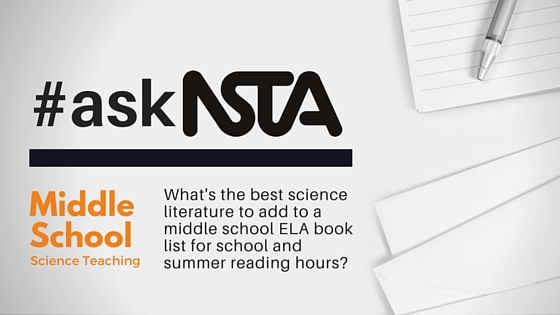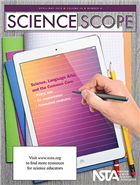Recommendations for Science-Focused Additions to a Middle School Reading List
By Lauren Jonas, NSTA Assistant Executive Director
Posted on 2016-04-11
Question of the Week on the Middle Level List Serve
“I’d really like to encourage my middle school (6-8) students to read more science literature for more robust discussions. In class, I have provided articles and short reading passages from various resources but 40 minutes a class isn’t enough, especially with lectures and labs. I’d like to have them read a science novel, fiction or nonfiction, outside science class. I know that our ELA teacher requires students to complete a certain number of hours for outside reading, and figured I could tag team with him. He’s on board with the idea of adding more science literature to the ELA book list for school and summer reading hours. I would add the titles so that at each grade would have 1 book per semester that we could focus on for science analysis and discussion. One of my limitations is that we don’t have a school library (don’t ask) so I would need titles that students can easily borrow from the public library, or titles that I can obtain in bulk and start a science class library without costing me my first born child. I’m reaching out for title suggestions for middle school (6-8) earth science, life science, and physical science. Right now I only have The Immortal Life of Henrietta Lacks for my life science and Regents Living Environment!”
—Cheska Robinson, @MissCheska, Middle school science teacher in New York
(question shared here with her permission)
Top Answers from NSTA Members
- For environmental science, I suggest Carl Hiaasen’s young adult books: Hoot, Flush, and Scat. They are high interest reading, appropriate for middle school, and well written. It would be especially nice to relate the environmental concerns back to your local issues.
- I enjoyed The Martian by Andy Weir (there’s a language modified school edition that takes out the f-bombs). That has a lot of physics and engineering problem solving (some of it seems plausible to a non-expect reader, but turns out to be fanciful).
- I like The Boy Who Harnessed the Wind. You can check out William Kamkwamba’s true story in three versions – elementary, middle school, and adult versions. He has two or three TED talks. It is wonderful!
- If you think you would get books to use year after year, try a donor’s choose grant to start.
- All of these books would be for life science.
Stiff: Curious Lives of Human Cadavers by Mary Roach (Very humor-filled; She discusses the uses of cadavers and it’s really interesting)
Survival of the Sickest by Dr. Sharon Moalem (Explains the reason why there are certain genetic diseases still in existence in our gene pool and also possibly how they even came about from an evolutionary standpoint.)
Spillover by David Quammen (Discusses all the various types of zoonotic diseases that have spilled over into the human population.)
The Mold in Dr. Florey’s Coat: The Story of the Penicillin Miracle by Eric Lax - I would add to the list:
Something out of Nothing, the Marie Curie Story.
The Secret of the Yellow Death (the story of the cause/cure for Yellow Fever)
Out of the Dust (adolescent story of surviving the dust bowl)
The Great Storm (adolescent story of surviving the Galveston Hurricane of 1900)
There’s a Hair in My Dirt (fun, short book by Gary Larson for environmental education) - I would add Life as We Knew It and House of the Scorpion. The first looks at the changes that occur when the moon is pushed closer to Earth and the second deals indirectly with the ethics of cloning.
What are some of your favorite science-focused books for middle school students? Please share your comments with us.
Join today and receive Science Scope, the peer-reviewed journal just for middle school teachers; connect on the middle level science teaching list (members can sign up on the list server); or consider joining your peers for Meet Me in the Middle Day (MMITM) at the National Conference on Science Education in Los Angeles in the spring of 2017.
The mission of NSTA is to promote excellence and innovation in science teaching and learning for all.
Future NSTA Conferences
5th Annual STEM Forum & Expo, hosted by NSTA
- Denver, Colorado: July 27–29
2017 Area Conferences
- Baltimore, Maryland: October 5–7
- Milwaukee, Wisconsin: November 9–11
- New Orleans, Louisiana: November 30–December 2
National Conferences
- Los Angeles, California: March 30–April 2, 2017
- Atlanta, Georgia: March 15–18, 2018
- St. Louis, Missouri: April 11–14, 2019
- Boston, Massachusetts: March 26–29, 2020
- Chicago, Illinois: April 8–11, 2021
Follow NSTA
Disclaimer: The views expressed in this blog post are those of the author(s) and do not necessarily reflect the official position of the National Science Teaching Association (NSTA).




